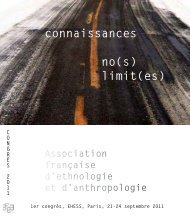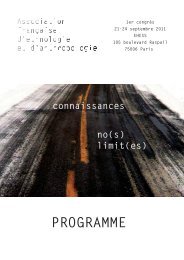state of the world's cities 2012/2013 - United Nations Sustainable ...
state of the world's cities 2012/2013 - United Nations Sustainable ...
state of the world's cities 2012/2013 - United Nations Sustainable ...
You also want an ePaper? Increase the reach of your titles
YUMPU automatically turns print PDFs into web optimized ePapers that Google loves.
Innovating to Support <strong>the</strong> Transition to <strong>the</strong> City <strong>of</strong> <strong>the</strong> 21st Centuryexceptions, modern urban planning has failed to integrate<strong>the</strong> urban poor in <strong>the</strong> socioeconomic fabric <strong>of</strong> <strong>the</strong> city.As an expert in Bangalore put it, “The poor have surviveddespite master planning.” 30 Understood primarily as atechnical tool, planning has been unable to address <strong>the</strong>power relations that have been at work to <strong>the</strong> detriment <strong>of</strong><strong>the</strong> great majorities <strong>of</strong> urban populations. Planning has alsoproved unable to prevent environmental degradation or <strong>the</strong>formation <strong>of</strong> slums, and is notable for serious shortcomingsin terms <strong>of</strong> transport and urban mobility.Conceived as a comprehensive, long-term strategy,a master plan – <strong>the</strong> quintessence <strong>of</strong> modern planning –typically represents an ideal end-<strong>state</strong> for a particular citywith serious gaps between <strong>the</strong> initial vision and actualresults. This has ensued in what a scholar in 1996 called“<strong>the</strong> dark side <strong>of</strong> planning” 31 , something an expert inMontevideo has referred to as “urban plans that are at oddswith <strong>the</strong> notion <strong>of</strong> prosperity.” 32The shortcomings <strong>of</strong> modern urban planning havetriggered significant reform since <strong>the</strong> 1980s and 1990s, in aneffort to move away from comprehensive plans, top-downdecision-making and wide-ranging regulation. 33 A moreflexible approach was adopted to improve conditions in<strong>cities</strong>, through ‘strategic planning’ and o<strong>the</strong>r methods thatare more pragmatic, incremental and typically focused on‘getting things done’. However, too many ‘strategic urbanplans’ have effectively imposed an entrepreneurial view <strong>of</strong><strong>the</strong> city, promoting mostly economic prosperity and <strong>of</strong>tenturning into marketing gimmicks in all but name, completewith oversized architectural designs and mega-developments.In emerging or developing countries, <strong>the</strong>se initiativestypically favour <strong>the</strong> gentrification <strong>of</strong> entire areas and, at times,massive displacement in order to make room for highways,skyscrapers, luxury compounds, shopping malls, etc., at <strong>the</strong>expense <strong>of</strong> <strong>the</strong> habitat and livelihoods <strong>of</strong> <strong>the</strong> poor. 34UN-Habitat policy analysis in 50 <strong>cities</strong> in Asia, Africa,Latin America and <strong>the</strong> Arab States (2011) shows that upto 80 per cent <strong>of</strong> localexperts believe that <strong>the</strong>benefits <strong>of</strong> economicfact Whatever<strong>the</strong> planning prosperity mainly serve <strong>the</strong>approach, powerfulinterests <strong>of</strong> <strong>the</strong> wealthy andpolitical and economic politicians (a view sharedinterests keep interferingby up to 90 per cent <strong>of</strong>with <strong>the</strong> design andAfrican experts). Throughimplementation <strong>of</strong>strategic plans andpolitical influence, bribery<strong>the</strong> pursuit <strong>of</strong> urban and corruption, <strong>the</strong>seprosperity for all.powerful interest groupsfactFrom Asia to Africa to Latin America, ‘master’,‘blueprint’ and layout plans have had similar,harmful consequences in countless numbers <strong>of</strong> <strong>cities</strong>: spatialsegregation, social exclusion, excessive mobility needs andconsumption <strong>of</strong> energy, toge<strong>the</strong>r with poor regard for <strong>the</strong>potential economies <strong>of</strong> scale and agglomeration that any citycan <strong>of</strong>fer. 29manage to distort urban plans, dodge spatial or legal rules,reduce <strong>the</strong> production <strong>of</strong> public goods and manipulate<strong>the</strong> power <strong>of</strong> eminent domain; in <strong>the</strong> process <strong>the</strong>ycapture unfair shares <strong>of</strong> a city’s potential, resources andprosperity to <strong>the</strong> detriment <strong>of</strong> large, poor majorities <strong>of</strong>urban populations.The New Urbanism Movement <strong>of</strong> <strong>the</strong> early 1980sbroke with conventional master-planning and introduceda number <strong>of</strong> welcome innovations: liveable, pedestrianfriendly<strong>cities</strong>, dense neighbourhoods with mixes <strong>of</strong>housing and job-creating commercial and business sites,toge<strong>the</strong>r with mixed land uses having a diversity <strong>of</strong>buildings in terms <strong>of</strong> style, size, price and function – all<strong>of</strong> this with a strong focus on local communities. 35 For all<strong>the</strong>se fresh efforts, though, a conventional approach tourban development has remained dominant to this day.In developing and emerging countries alike, <strong>cities</strong> are stillhostages to a mix <strong>of</strong> homogeneous forms or functions on<strong>the</strong> one hand, and spatial /social segregation on <strong>the</strong> o<strong>the</strong>rhand. Urban areas continue to expand across endlessperipheries, with serious, pervasive problems <strong>of</strong> trafficcongestion, enhancing <strong>the</strong> dependence on motor vehiclesand intensive use <strong>of</strong> expensive fossil fuels. This dominanttype <strong>of</strong> city is detrimental to <strong>the</strong> built heritage and <strong>the</strong>environment, includingsurrounding agriculturalland, as well as biodiversity.Today, <strong>the</strong>This is <strong>the</strong> pattern whichfact GS20CUN-Habitat refers to asmodel appears to be<strong>the</strong> “Global Standardpredominant acrossUrbanization Model<strong>the</strong> world, being<strong>of</strong> <strong>the</strong> 20th Century”largely driven by land(GS20C), 36 whichspeculation and reale<strong>state</strong> interests thatprivileges individualism,build <strong>cities</strong> according toconsumerism, newfinancial and economic(artificial) values andparameters <strong>of</strong>tenlifestyles, excessive mobility radically at odds withand privatization <strong>of</strong> <strong>the</strong>shared prosperity. 37public space.109





